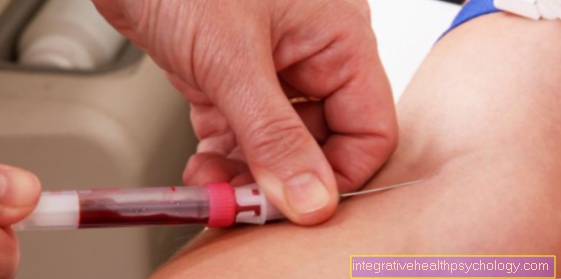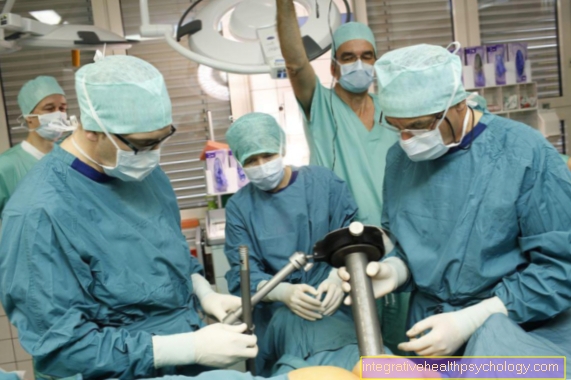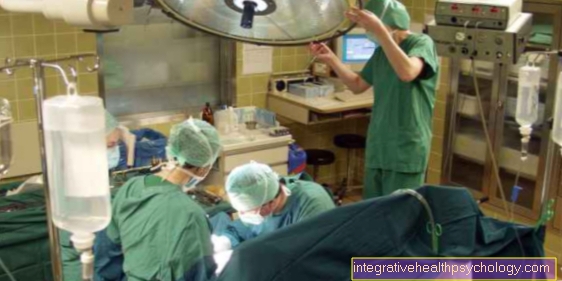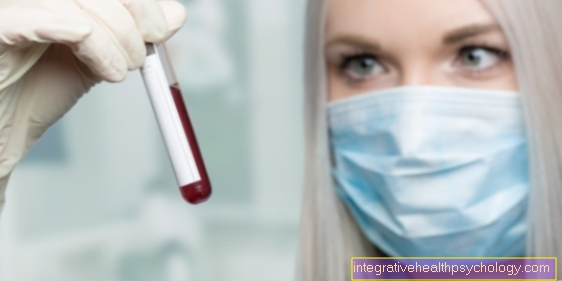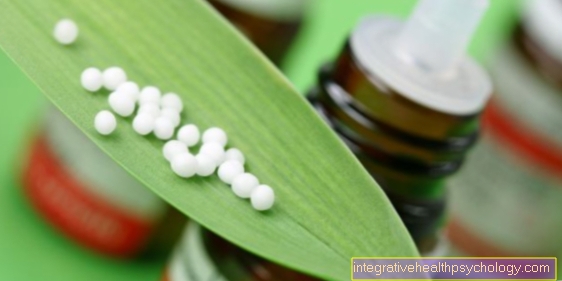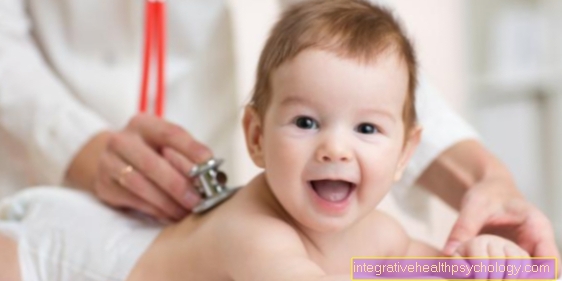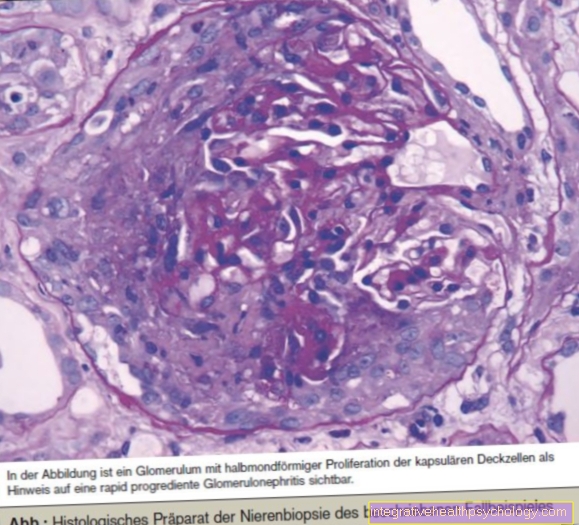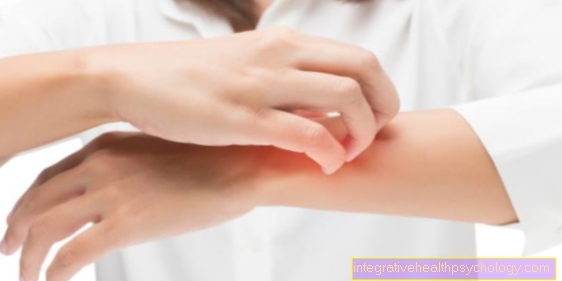Pus pimples on the bottom
Definition - What is a pus pimple on the buttocks?
A pus is a small cavity in the skin that is filled with purulent secretion. In dermatology (dermatology) pus become the so-called primary skin changes (technical term: Primary lesions) counted. Although it is generally possible for the secretion inside the pus to be sterile, a pus on the buttocks in most cases has an infectious component.
First, find out more about the subject of "pus pimples" in general. The most important information is summarized in the following article: What is a pus pimple?

Introduction - pus pimples on the buttocks
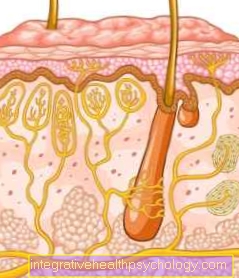
A pus pimple on your bottom is not just considered unsightly. Due to the localization, a pus pimple on the buttocks can even lead to severe pain. Depending on the size of the skin change, both walking and sitting can be extremely painful for those affected.
The appearance of a pus pimple on the buttocks can be observed especially in adolescents and young adults. The reason for this is mostly the hormonal changes during adolescence. However, the increased occurrence of pus pimples in young people can be problematic. It is precisely this group of people who usually attach greater importance to external appearance. Many young people even define themselves completely by their appearance.
For this reason, skin changes can be very stressful for those affected. This can even lead to the fact that young people who suffer from pus pimples on their buttocks limit their own lives and no longer dare to go to the swimming pool, for example. The psyche of the affected person can therefore also be strongly influenced by pus pimples on the buttocks.
Although there are several factors that are thought to promote the development of pus pimples, genetic predisposition seems to play a much more decisive role.
Nevertheless, both changing eating habits, thus eating right, and changing certain habits can help to improve the complexion in the long term.
Especially if a pus pimple occurs on the buttocks, this can be related to poor clothing or poor hygiene. Over-the-counter ointments and creams, such as those offered in every drugstore, only rarely lead to an improvement in the skin's appearance. Often times, regular use of these products actually makes the skin seem worse.
For this reason, people who frequently suffer from pus pimples on their buttocks should not hesitate to consult a specialist; in most cases, only a dermatologist (Dermatologist) Assess the complexion professionally, determine the cause of the repeated occurrence of pus pimples on the buttocks and initiate effective treatment.
Hormonal changes occur during puberty. These lead to numerous sequelae on the body. You can find out what these are in our article: What happens to my body during puberty?
Causes of pus pimples on the buttocks
The causes that lead to the repeated occurrence of a pus pimple on the buttocks are in most cases completely harmless and can be treated without any problems.
Especially in the warm months, profuse sweating can worsen the complexion and pus pimples appear on the buttocks. The reason for this is the fact that the bottom is mostly covered with fabric, even in warm weather. If the skin begins to secrete sweat, it collects in the area of the pants and attacks the skin surface.
In this way, the sebum produced within the skin can no longer drain properly and the pore becomes clogged. The origin of every pus pimple is therefore primarily a clogged pore in the skin.
Especially the hormonal changes during puberty, pregnancy and / or menopause can promote this process.
In addition, a warm, humid environment, such as that created by wearing clothes on your buttocks on warm days, is an ideal habitat for bacterial pathogens.
These germs can penetrate the skin along the clogged pores and provoke the development of inflammatory processes there and thus promote the formation of a pus pimple.
Another reason for the repeated occurrence of a pus pimple on the buttocks is strong friction between the skin surface and clothing. In addition, synthetic substances and intolerance (or allergies) to various detergents or fabric softeners are the most common causes of pus pimples on the buttocks.
Furthermore, it can be observed that especially people whose buttocks are frequently exposed to strong irritation tend to develop pus pimples on their buttocks. In this context, regular cycling and tight legwear play a decisive role.
In addition, men seem to be affected by a pus pimple on their buttocks far more often than women. The reason for this is the fact that ingrown hairs are the main cause of the development of pus pimples on the buttocks. Although a pus pimple on the bottom is therefore of completely harmless origin in the majority of cases, such skin symptoms can also be caused by pathological changes.
Especially in adults, the development of a pus pimple on the bottom can be caused by what is known as acne inversa. This is a chronic disease of the sebum glands and / or hair follicles, which is often associated with particularly painful pus pimples. As this disease can even lead to extensive abscesses, a dermatologist must be consulted promptly and appropriate treatment initiated.
What skin diseases are there? Make sure that there are no other skin changes besides the pus pimple. Find out more about this at: Skin disorders
Treatment of pus pimples on the buttocks

Therapy for a pus pimple on the buttocks includes various treatment strategies. The choice of the most suitable therapy depends primarily on the cause of the appearance of the skin change.
Small pus pimples or blackheads, as they often occur in the course of acne, can usually be treated effectively by adjusting your hygiene. Affected people should make sure that the skin on their buttocks is cleaned regularly. When cleaning the buttocks, care should be taken to ensure that fragrance-free, pH-neutral washing lotions and creams are used. Aggressive care products can attack the surface of the skin and cause the skin to deteriorate further and new pus pimples appear on the bottom. In addition, affected people should remember that oily or oily skin creams clog the pores and thus promote the development of pus pimples. For this reason, it should be ensured that only water-based skin creams are used, especially in the warm seasons. This principle also applies to sunscreens and after-sun lotions.
If you have a particularly large pus pimple on your bottom, you should go to the dermatologist without delay. Only they can properly assess the complexion and initiate targeted treatment.
For some of the people affected, drug therapy may be unavoidable. Drug treatment for a pus pimple on the buttocks can be from the outside (through creams or ointments), as well as from the inside. Skin creams that contain an antibiotic and / or vitamin A acid are particularly suitable for treating pronounced pus pimples on the buttocks.
Affected persons should under no circumstances press the pus themselves. This can have serious consequences.
Enzyme peels can also help to ensure the purity of the skin and allow the pores to breathe. One example of this is the Dr. Severin enzyme peeling from the pharmacy.
What additional measures can you take even if you have a pus pimple on your bottom?
People who regularly suffer from pus pimples on their buttocks often wonder what they can do about this problem in the long term. A pus pimple on the buttocks can be treated in different ways for most of those affected. As a rule, however, the most suitable therapy strategies can only be selected after a comprehensive diagnosis. The reason for this is the fact that an effective treatment of a recurring pus pimple on the buttocks must primarily be tailored to its cause.
However, since the majority of those affected find it uncomfortable to see a specialist because of a pus pimple on their buttocks, they often wonder what they can do themselves.
First and foremost, it helps to focus on extensive hygiene in the event of a recurring pus pimple on the buttocks. The surface of the skin on the bottom should be cleaned with lukewarm water at regular intervals. This is especially true in warm seasons.
In addition, it helps to ensure that only fragrance-free and pH-neutral washing lotions or creams are used in skin care. Aggressive cleaning agents can cause the surface of the skin of the buttocks to be attacked and the complexion to deteriorate. As a result, a pus pimple can occur more often.
In addition, the skin on the bottom should be kept dry after cleaning. For this reason, oily and oily skin creams are not suitable for the care of the buttocks skin.
If these measures are unsuccessful and pus pimples continue to occur regularly on the buttocks, changing clothes can be useful. Airy trousers can help to reduce sweat production in the area of the buttocks and thus prevent the development of pus pimples.
If the occurrence of pus pimples on the bottom cannot be avoided even with this measure, the only way out is to visit a specialist in dermatology (Dermatologist). This is the best way to assess the complexion of the buttocks, determine the cause of the pus pimples and initiate appropriate treatment.
As a rule, the therapy takes place with special creams or ointments prescribed by the dermatologist. These products ensure that the inflammatory processes are contained and cannot spread any further. In particular, the use of antibiotic or vitamin A acid-containing care products has proven itself in the treatment of pus pimples on the buttocks.
The best measure to treat and prevent pus pimples on the buttock area is clearly to take proper care of the skin on the buttocks. But what does the perfect skin care look like? To do this, read our article: Proper skin care
Should you express pus pimples on the bottom?
A pus pimple on the buttocks should only be expressed independently if no other option is available and then only under the right conditions, as otherwise pathogens can pass into the blood and trigger an infection.
Before the pus pimple is expressed on the buttocks, hands, the skin around the pus pimple and the pus pimple itself should be disinfected.
It is also important that you stop pressing if the pimple does not empty after three attempts.
If it is a very large pus pimple, it should not be emptied independently. It is best to consult a doctor, especially if you have severe symptoms.
At this point, you can read how you can get rid of pimples in general and thus prevent them from recurring: How to Get Rid of Pimples
Pus pimples on the bottom of babies / toddlers / children
Children, toddlers and babies in particular are particularly often affected by small pus pimples on their buttocks. If this form of the rash appears only as a single pus pimple on the bottom, there is usually no need to worry.
However, pus pimples can also appear on entire skin areas of the buttocks. This phenomenon particularly affects those babies or toddlers who regularly wear diapers. The reason for this is the fact that the sensitive skin on the buttocks is attacked by constant contact with urine or stool. As a result, the fine pores on the bottom tend to clog faster. In addition, the bottom covered by a diaper offers a baby, toddler or child an ideal habitat for bacterial pathogens. Bacteria that also settle on the healthy surface of the skin can multiply inside the diaper and attack the surface of the skin.
The so-called diaper rash is particularly common in babies and toddlers. Especially between the ninth and twelfth month of life, this form of skin rash is one of the most common reasons to think about it in a pediatrician's practice. Even older children who occasionally wear diapers, for example during the night, can develop such a diaper rash with small pus pimples on their buttocks.
A diaper rash (technical term: Diaper rash), which can lead to the development of small pus pimples on the bottom, usually takes on a very classic appearance. In the affected baby or toddler, the part of the skin on the buttocks that is covered by the diaper is red and inflamed. The affected skin areas can have small pus pimples, appear dry, oozing or shiny. The uncovered skin of the buttocks, on the other hand, is completely inconspicuous.
An untreated diaper rash in a baby, toddler, or child can cause serious complications. Often the affected children develop bacterial or fungal infections. For this reason, it is advisable to ensure that the diaper of a baby or toddler is changed immediately after defecation and urination, especially in the warm seasons. In addition, the sensitive skin on the bottom should be cleaned with particularly mild products and kept dry at all times. The development of a pus pimple on the bottom of a baby or toddler can also be prevented by not using a diaper on the child on hot days. In addition, one should always strive to wean from wearing diapers as early as possible, including during the night.
In addition, a build-up of small pus pimples on the bottom of a baby, toddler or child can be the first sign of a viral infection. Typically, the rash with viral infections in babies, toddlers or children is more likely to appear on the trunk of the body. However, small pus pimples can also be observed more and more frequently on the buttocks.
For detailed information, read our article: Diaper rash
Symptoms of pus pimples on the buttocks
Usually, the pus pimple on the buttocks doesn't cause any symptoms besides mild to severe pain. Depending on where the pimple is located, sitting or lying down can be associated with pain and disrupt everyday life and night sleep.
If the pus pimple is full, a feeling of pressure can also be felt at the location of the pimple.
If the pus or boil is large, a fever may also occur in response to the inflammation. Other general symptoms such as fatigue and tiredness are seldom possible. If the pimple is squeezed out, the inflammation can spread and the symptoms become more extensive. If the pus or boil is triggered by bacteria such as staphylococci and if these pass into the blood, even if only rarely, this can lead to blood poisoning (sepsis) with a high fever and even clouding of consciousness.
As you can see from the passage of text, inflammation of pus pimples on the buttocks can have serious consequences. Find out more about inflammation of a wound at: Inflammation of a wound - you have to pay attention to this!





